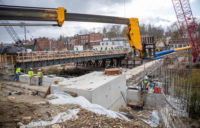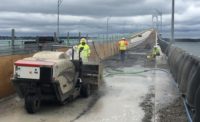The Grist Mill Bridge, a 75-ft single-span bridge in Hampden, Maine, is the first in the nation to use composite tub girders with no concrete reinforcement in the superstructure, say officials. The five fiberglass-reinforced polymer (FRP) composite beams and other corrosion-resistant features are also expected to extend the design life of the hybrid composite concrete bridge by at least 100 years, according to Wayne Frankhauser, bridge program manager for the Maine Dept. of Transportation.
Recently opened to traffic, the bridge is part of an $8.9-million Hampden road reconstruction and paving project along a two-mile stretch of 1A scheduled for final completion in June. The two-lane bridge carries about 6,400 vehicles per day over the Souadabscook Stream, due north of downtown Hampden.
Recognizing the benefits of the tub girder system, Maine DOT is bidding a second, nearly $2-million project that will use the technology on Route 69 in Hampden.
“In addition to the corrosion-resistant, low-maintenance aspect of the composite girder system, Maine DOT looks forward to the improving competition in the supply of materials for bridges in the Grist Mill Bridge size range to help drive down cost," Frankhauser says. “We’re pretty excited about the technology and the promise it has for bridges in the state."
A similar bridge is being designed in Westerly, R.I., with another two gearing up in Sun Island and Marco Island, Fla., according to the designer and supplier of structural components for the Grist Mill Bridge. A spokesman for Brewer, Maine-based Advanced Infrastructure Technologies (AIT) says, “The bridges in Maine and Florida will be built this spring summer and fall.”
The spokesman says AIT, which licenses the composite girder technology from the University of Maine, will bid on the Rhode Island bridge project in fall with construction expected to start in spring 2022.
FRP Advantage
Prior to construction, crews had to demolish and remove three steel bridges that had been built one on top of the other over the years instead of replacing the span, leaving the structure resembling “a bridge built on a branch,” Frankhauser says. The oldest part of the original bridge was built nearly a century ago and the newest part was 72 years old, he notes. “It was in poor condition from fairly standard deterioration of the concrete due to exposure to the elements and deicing chemicals. It had a good long life, but its current bridge condition ratings were poor for the substructure and the superstructure, so that led us to prioritize it for bridge replacement.”
The “overwhelming advantage” of the fiberglass reinforced polymer girder system on the new bridge is that it is lightweight, says Brian Emmons, project manager for the Grist Bridge’s general contractor, T. Buck Construction. The Turner, Maine-based firm’s team also set two sewer lines, which were hanging from one pick, and a single water main hanging from another pair of beams. “In this case, we had to pre-plan knowing we couldn’t do the task later,” Emmons says.
“We blocked the beams on the ground to simulate abutments, then connected two girders so we could hang the utility lines under them and fly the whole assembly into place at once,” Emmons explains. “With traditional steel girders, such as I-beams, we could have set them without the utility lines because they provide more ways to access the hanging lines from the girders."
The cost of transporting FRP girders to the jobsite is significantly less than transporting traditional girders, since composites are roughly 35% lighter than steel and concrete and little equipment is needed to place the beams, Sweeney explains.
What’s unique about the vertical U-shaped girders is that they are stackable, says Habib Dagher, executive director of the Advanced Structures and Composites Center at UMaine, which holds the patent for the hybrid composite concrete bridge and assembly method. “You can ship 15 girders, equivalent to three to four bridges on one stretch flatbed truck, compared to 15 concrete double T-girders which would need 15 trucks,” he says.
The top plates for the beams were pre-installed before arriving at the jobsite, so they could not and did not need to be nested, Emmons says. “If we had a large number of girders, nesting them would be a huge advantage, as often times transportation to a jobsite can get extremely expensive.”
When the two-day installation finally got underway Nov. 5, five 76-ft-long x 4-ft-wide girders were delivered on a stretch trailer in three deliveries of two double-beam deliveries and one single one. “The first pick of the day included two girders with two sewer mains connected underneath,” says Emmons. The second pick was the single girder and the last two beams, which had a single waterline underneath, were set the next day.”
Once beams were set using a single crane, crews installed falsework floors between the girders and edge/end forms for concrete placement with stainless steel reinforcement. “The beams are pretty stable, but as a safety measure we installed ‘kickers’ at each end of the beams, which are not secured to the concrete below until the concrete is placed around and over them,” Emmons explains.
Following that, crews installed the concrete deck on top just as planned, says Ken Sweeney, AIT Bridges president and chief engineer. “[Emmons] had his homework all figured out using typical bridge formwork, since there was no need to use anything special to work with the girders,” Sweeney recalls.
All Academic
The FRP composite girders were designed by AIT in partnership with the University of Maine. The university field-load-tested the bridge on Dec. 30 and 31 with support from AIT Bridges and Maine DOT. “This was a great opportunity because it was the first bridge of its kind,” says Bill Davids, department chair of civil and environmental engineering at UMaine and project lead for the composite tub girder system.
“We put 20 sensors on it to measure strain, and more than 260,000 pounds of load was applied via four trucks considering multiple load configurations,” he explains. “This gives us baseline information on the performance of the bridge and tells us how it really behaves in the field, and will allow AIT to refine design methodologies.”
Additional research is underway with support from the Transportation Infrastructure Durability Center, AIT Bridges, and Maine DOT involving web shear strength testing to develop refined design values; continued development and experimental assessment of girder-slab shear connectors and strength; and creep testing of 58-ft long girders with full-length precast decks.
The time-saving benefits of the technology also helped offset delays on the Grist Bridge project that the team attributed to procuring materials and labor during the COVID-19 pandemic. “We needed every minute we could get,” Emmons recalls. “But we expect to finish the [overall] project on time by the final completion date.”






Post a comment to this article
Report Abusive Comment